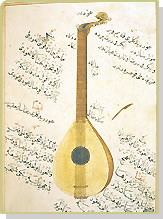 Lavta
Lavta
TURKISH CLASSICAL MUSIC
MAKAMS
MAKAM
Turkish art music can be considered within the makam music that is common from Central Asia to the entire Mediterranean basin. Turkish music is a monophonic musical tradition founded on the principle of makam. Though the Turkish makams resemble the makam traditions of surrounding cultures, they contain their own unique characters of style and execution. The name "makam" is the term applied to the whole of rules that describe melodic progression patterns (seyir) within musical scales, which are in turn founded on particular orders of intervals. The development and performance of makams exhibit changes according to different periods and theoreticians. The concept of makam, on which Turkish music theory is founded, has different meanings in Turkish classical and various local folk music traditions, and consequently shows clear differences in practice.
MAKAMS
Over four hundred makams exist in Turkish music; however the vast majority of these are no longer in use today. There are several different systematic approaches to the subject of makam, chief of which are the Arel-Ezgi-Uzdilek system, the Karadeniz System, and the Gürmeriç system. Without addressing all the differences in makam classification and nomenclature, we will give just their names as they are most widely known today. The makams are classified into three main sections: Basit (simple) makams, Sed (transposed) makams and Birlesik (compound) makams.
Basic Makams: Çargah, Buselik, Basit Sehnaz, Beyati Basit Isfahan, Hicaz, Humayun, Uzzal,Zirgüleli Hicaz, Hüseyni,Muhayyer, Gülizar, Neva, Tahir, Karcigar, Basit Süznak.
Transposed and Compound Makams: Because the transposed makams are still the subject of debate and several theoreticians claim that they display characteristics of compound makams, we will give the names of the transposed and compound makams together here: Mahur, Acem Asran, Nihavend, Ruhnüvaz, Sultan-i Yegah, Kürdili Hicazkar, Askefza, Ferahnüma, Zirgüleli Süznak, Hicazkar, Evcara, Suz-i Dil, Sedd-i Araban, Reng-i dil, Nisabur, Segah, Segah Maye, üstear, Hüzzam, Vech-i Arazbar, Isfahan, Ifahanek, Beyati Araban, Acem, Acem Kürdi, Hisar, Hisar Buselik, Sehnaz, Arazbar, Saba, Dügah, Kûçek, Sipihr, Gerdaniye, Muhayyer Sümbüle, Dügah Maye, Sultan-i Irak, Nisaburek,, Nikriz, Neveser, Pesendide,Güldeste, Tarz-i Nevin, Nihavend-i Kebir, Zavil, Pençgah, Pençgah-i asil, Pençgah-i Asil, Sûz-i Dilara, Büzürk, Sazkar, Rehavi, Sevk-i Dil, Irak, Eviç, Bestenigâr, Beste-Isfahan, Rahat'ül-Ervah, Dilkes-Haveran, rûy-i Irak, Revnak-Nüma, Hüzzam-i Cedid, Ferahnak, Sevk-u Tarab, Sevk-Aver, Tarz-i Cedid, Hüseyni Asiran, Buselik Asiran, Asiran Zemzeme, Nühüft, Can-Feza, Saba Asiran, Rahat Feza (Hicaz Asiran-Hicaz-i Muhalif), Zirefkend, Ferahfeza, Dilkeside, Lalegül, Sultan-i Segah, Seref-Nüma, Sive- Nüma, Yegah, Acemli Yegah, Anber-efsan, Bahr-i Nazik, Çargah Gerdaniye, Cihar-Agazin, Dügah-i Hicaz, Usak Huzi, Evc Huzi, Evc-Isfahan, Evic-Muhalif, Hicazi Ussa, Hicaz Zemzeme, Selmek, Bezm-i Tarab, Eviç-Nihavendi, Eviç-Maye, Hicaz-Irak, Sehnaz-Haveran, Asiran Maye, Gülzar, Hicazeyn, Huzi-Asiran, Bend-i Asiran, Dil-Ruba

